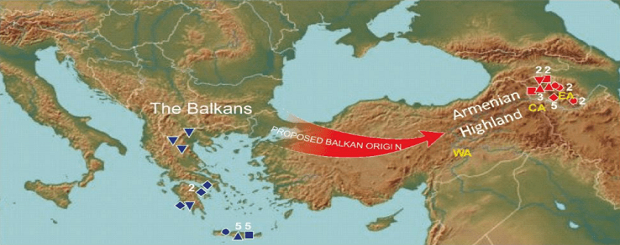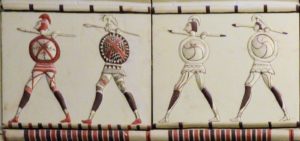
Art-A-Tsolum – New DNA study rejects the Balkan origin of Armenians
JULY 12, 2020 – New DNA:– Art-A-Tsolum – PREVIOUS ARTICLE:
Armenians are in many ways a unique ethnic group in the Near East. For one the Armenians speak a separate isolated branch within the Indo-European language family. Armenians are also genetic isolates showing little to no admixture since the Bronze Age collapse, and are considered one of the few ancient representatives of the Near East.
Although there is little research into the origins of the Armenian people, there has been no lack of speculation on the ethnogenesis of these people. One of the long prevailing theories was that the Armenians came from the Balkans being themselves Phrygian colonists. This theory has been proposed in the antiquity. Ancient Greek historian Herodotus for example (440 B.C.), suggested that Armenians were Phrygian colonists because the Armenian soldiers in Persian employ were supposedly equipped like the Phrygians.
“the Armenians were equipped like Phrygians, being Phrygian colonists”

A new study (by Hovannisyan et. al. 2020) titled: “An admixture signal in Armenians around the end of the bronze age reveals widespread population movement across the Middle-East” still in pre-print, tries to weigh in on the discussion making some interesting discoveries, including the rejection of the “out of Balkan theory” for Armenians.
The study says the following:
We focused on solving a long-standing puzzle regarding Armenians’ genetic roots. Although the Balkan hypothesis has long been considered the most plausible narrative on the origin of Armenians, our results strongly reject it, showing that modern Armenians are genetically distinct from both the ancient and present-day populations from the Balkans. On the contrary, we confirmed the pattern of genetic affinity between the modern and ancient inhabitants of the Armenian Highland since the Chalcolithic, which was initially identified in previous studies.
…modern and ancient samples from the Balkans appear significantly distant from the Armenian cluster and are drawn mostly toward other European populations.

Principal component analysis (PC1 vs PC2). Values in parenthesis represent the percentage of variance explained by a given PC. According to the PCA, ancient samples from the Armenian Highland cluster with contemporary Armenians, while modern and ancient samples from the Balkans show distinctive clustering closer to other European populations. – A. Hovhannisyan et. al (2020).
Sardinian-like admixture
This study further found a mysterious admixture event during the middle/late Bronze Age with an unknown population that have also contributed to the modern people of the island of Sardinia. The study suggests that this mysterious source population came from the Middle-East.
We found that the genetic continuity in the Armenian Highland was disrupted during the second half/after the end of the Bronze Age by an input from a Sardinian-like source. The time scale for this input, as well as its source, coincide with a similar event detected in East Africa, suggesting large scale population movements from the Middle East going North and South. Our analyses failed to find a good source for this expansion among the available aDNA samples.

Regarding the age of the admixture the authors aren’t very clear. The only test they did to establish the age suggests an Early Bronze Age, but they seem to hypothesize a late Bronze Age admixture.
The timing of the admixture obtained from ALDER suggests a relatively old event (the best signal corresponds to 172.56 +/- 17.23 generations ago), which is closer to the end of the Early Bronze Age in Armenia.
The study concludes that whether such large-scale population movement was a result of climatic or cultural changes is unclear, as well as the true source of gene flow remains an open question.
The authors also seem to reject an Iranian admixture for Armenians:
According to recent studies, 38-44% of the ancestry of modern Sardinians is derived from an Iranian, Steppe and North-African-related source. Likewise, we did not reveal any Iranian-related ancestry in modern Armenians that may have altered them from their regional ancestors.
Thus, it is more likely that the true source of gene flow to the Armenian Highland is yet unsampled.
Could these be the traces of the mysterious “Sea People” who have ravaged ancient Egypt during the late Bronze Age and for long been hypothesized to have actually caused the Bronze Age collapse?

Their identity is just as mysterious. Some have suggested that the Sea People were refugees from the legendary city of Troy, others have claimed them to have come from the mythical “Atlantis” yet others hypothesized Etruscan settlement. If their roots however are in the Middle-East then a Phoenician origin is perhaps more plausible. Or are these the people of Hayk from Babylon? I guess all bets are off.
Genetic continuity
When it comes to the Armenian genetics the study largely concludes that modern Armenians are direct descendants of Neolithic inhabitants of the Armenian Highlands who only once (during the Bronze age) have experienced an admixture event from these “Sardinian-like” people, for the lack of better terms.
Our study, based on a combined dataset of modern and ancient genomes from the Armenian Highland, revealed a strikingly high level of regional genetic continuity for well over six thousand years, with only one detectable input from a Sardinian-like source during the Late Bronze Age or after.
This pattern stands in contrast to most other Western Eurasian populations, which have undergone multiple large influxes.
A high level of continuity sets the Armenian population apart even in comparison to the Sardinians, who have long been considered as a genetic isolate in the region since the Neolithic, but recent studies have shown that the island received numerous genetic inputs after the Bronze Age.
Previously a study by Haber et. al. (2015) concluded that the Armenians emerged from a mixture of multiple populations during the Bronze Age. This study seems to disagree with such a conclusion, saying that:
We could not find any evidence for mixtures of multiple populations during the time period of 3,000–2,000 BCE. In contrast, we found a signal for a single admixture event from a Sardinian-like source which happened after the Early Bronze Age
These findings are of course very interesting and again disprove the already shaky “out of Balkan” theory for Armenians. However, rash conclusions should also be avoided, the lack of ancient samples from the region leaves much to the imagination and the authors haven’t been able to process some of the newly released ancient DNA data like that of the Chalcolithic and Early Bronze Age Arslantepe samples, where modern Armenians seem to cluster so close to. Thus there is no doubt that more study is needed and comparisons with ancient east-Anatolian DNA, preferably from and around the region of Van. I’ll leave you with the following summarizing conclusions the authors made:
We show that Armenians have indeed remained unadmixed through the Neolithic and at least until the first part of the Bronze Age, and fail to find any support for historical suggestions by Herodotus of an input from the Balkans. However, we do detect a genetic input of Sardinian-like ancestry during or just after the Middle-Late Bronze Age. A similar input at approximately the same time was detected in East Africa, suggesting large-scale movement both North and South of the Middle East. Whether such large-scale population movement was a result of climatic or cultural changes is unclear, as well as the true source of gene flow remains an open question that needs to be addressed in future ancient DNA studies.
Source: www.biorxiv.org/content/10.1101/2020.06.24.168781v1.abstract
